Financialization's Influence on Organizational Innovation and Culture
VerifiedAdded on 2023/01/06
|7
|1851
|68
Essay
AI Summary
This essay delves into the multifaceted relationship between financialization, organizational culture, and innovation. It begins by defining innovation and its phases, emphasizing the role of innovation workers and the significance of a creative work environment. The essay then explores financialization, its impact on non-financial corporations, and its connection to globalization. It analyzes how financialization influences management practices and potentially enhances or impedes innovation. The author argues that financialization's impact is mixed, potentially hindering innovation by creating market-related crises and impacting the company's objectives, but also potentially helping the company in seeing better amount of innovation flow. The essay further examines the varied effects of financialization on non-financial organizations, including its influence on company objectives and financial operations. The essay concludes by summarizing key findings, highlighting the complex interplay between financialization, culture, and innovation in driving business outcomes.

Culture and climate for innovation
Paraphrase This Document
Need a fresh take? Get an instant paraphrase of this document with our AI Paraphraser

TABLE OF CONTENTS
ESSAY.............................................................................................................................................1
Is this development likely to enhance or impede innovation within organizations?..................3
REFERENCES................................................................................................................................5
ESSAY.............................................................................................................................................1
Is this development likely to enhance or impede innovation within organizations?..................3
REFERENCES................................................................................................................................5
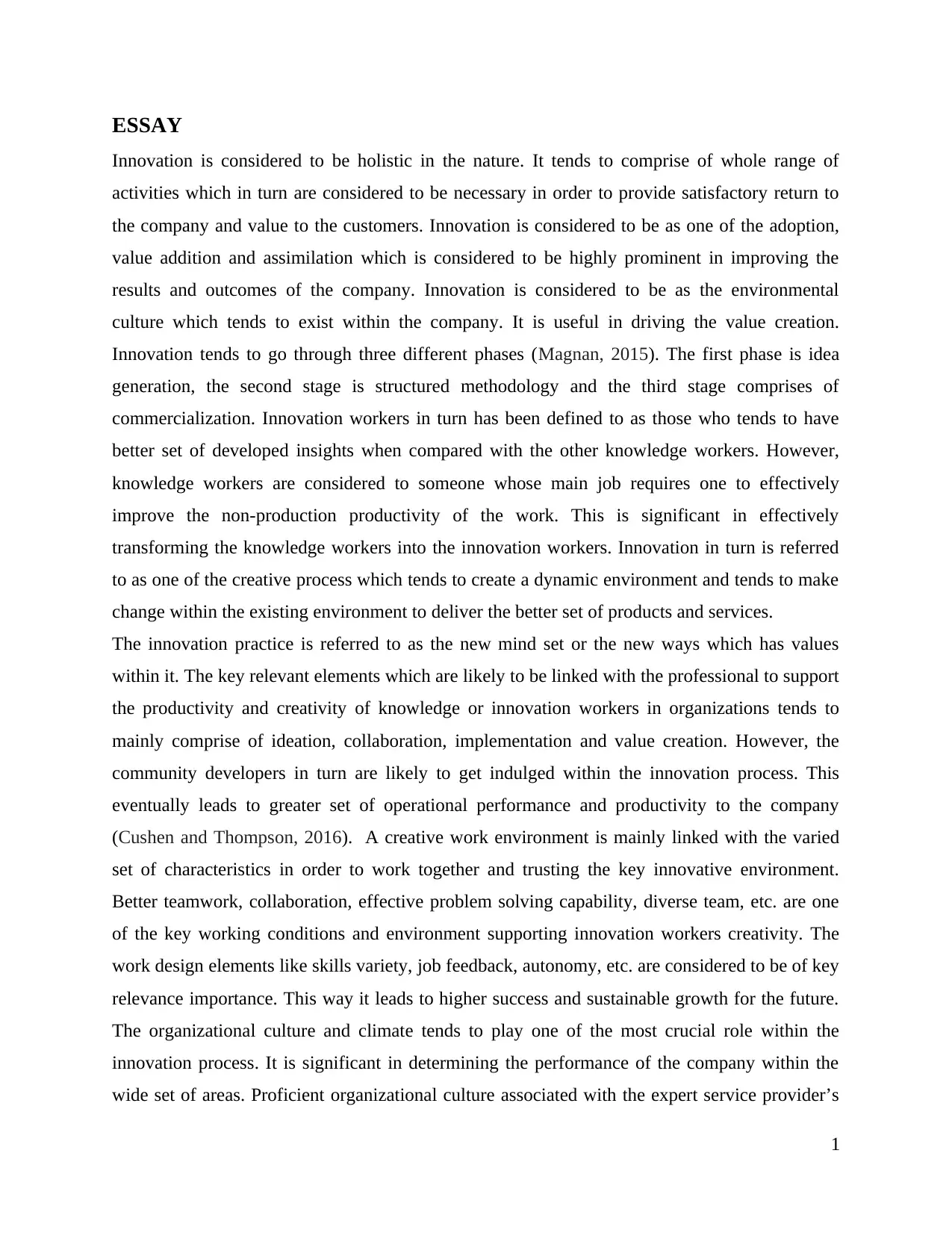
ESSAY
Innovation is considered to be holistic in the nature. It tends to comprise of whole range of
activities which in turn are considered to be necessary in order to provide satisfactory return to
the company and value to the customers. Innovation is considered to be as one of the adoption,
value addition and assimilation which is considered to be highly prominent in improving the
results and outcomes of the company. Innovation is considered to be as the environmental
culture which tends to exist within the company. It is useful in driving the value creation.
Innovation tends to go through three different phases (Magnan, 2015). The first phase is idea
generation, the second stage is structured methodology and the third stage comprises of
commercialization. Innovation workers in turn has been defined to as those who tends to have
better set of developed insights when compared with the other knowledge workers. However,
knowledge workers are considered to someone whose main job requires one to effectively
improve the non-production productivity of the work. This is significant in effectively
transforming the knowledge workers into the innovation workers. Innovation in turn is referred
to as one of the creative process which tends to create a dynamic environment and tends to make
change within the existing environment to deliver the better set of products and services.
The innovation practice is referred to as the new mind set or the new ways which has values
within it. The key relevant elements which are likely to be linked with the professional to support
the productivity and creativity of knowledge or innovation workers in organizations tends to
mainly comprise of ideation, collaboration, implementation and value creation. However, the
community developers in turn are likely to get indulged within the innovation process. This
eventually leads to greater set of operational performance and productivity to the company
(Cushen and Thompson, 2016). A creative work environment is mainly linked with the varied
set of characteristics in order to work together and trusting the key innovative environment.
Better teamwork, collaboration, effective problem solving capability, diverse team, etc. are one
of the key working conditions and environment supporting innovation workers creativity. The
work design elements like skills variety, job feedback, autonomy, etc. are considered to be of key
relevance importance. This way it leads to higher success and sustainable growth for the future.
The organizational culture and climate tends to play one of the most crucial role within the
innovation process. It is significant in determining the performance of the company within the
wide set of areas. Proficient organizational culture associated with the expert service provider’s
1
Innovation is considered to be holistic in the nature. It tends to comprise of whole range of
activities which in turn are considered to be necessary in order to provide satisfactory return to
the company and value to the customers. Innovation is considered to be as one of the adoption,
value addition and assimilation which is considered to be highly prominent in improving the
results and outcomes of the company. Innovation is considered to be as the environmental
culture which tends to exist within the company. It is useful in driving the value creation.
Innovation tends to go through three different phases (Magnan, 2015). The first phase is idea
generation, the second stage is structured methodology and the third stage comprises of
commercialization. Innovation workers in turn has been defined to as those who tends to have
better set of developed insights when compared with the other knowledge workers. However,
knowledge workers are considered to someone whose main job requires one to effectively
improve the non-production productivity of the work. This is significant in effectively
transforming the knowledge workers into the innovation workers. Innovation in turn is referred
to as one of the creative process which tends to create a dynamic environment and tends to make
change within the existing environment to deliver the better set of products and services.
The innovation practice is referred to as the new mind set or the new ways which has values
within it. The key relevant elements which are likely to be linked with the professional to support
the productivity and creativity of knowledge or innovation workers in organizations tends to
mainly comprise of ideation, collaboration, implementation and value creation. However, the
community developers in turn are likely to get indulged within the innovation process. This
eventually leads to greater set of operational performance and productivity to the company
(Cushen and Thompson, 2016). A creative work environment is mainly linked with the varied
set of characteristics in order to work together and trusting the key innovative environment.
Better teamwork, collaboration, effective problem solving capability, diverse team, etc. are one
of the key working conditions and environment supporting innovation workers creativity. The
work design elements like skills variety, job feedback, autonomy, etc. are considered to be of key
relevance importance. This way it leads to higher success and sustainable growth for the future.
The organizational culture and climate tends to play one of the most crucial role within the
innovation process. It is significant in determining the performance of the company within the
wide set of areas. Proficient organizational culture associated with the expert service provider’s
1
⊘ This is a preview!⊘
Do you want full access?
Subscribe today to unlock all pages.

Trusted by 1+ million students worldwide
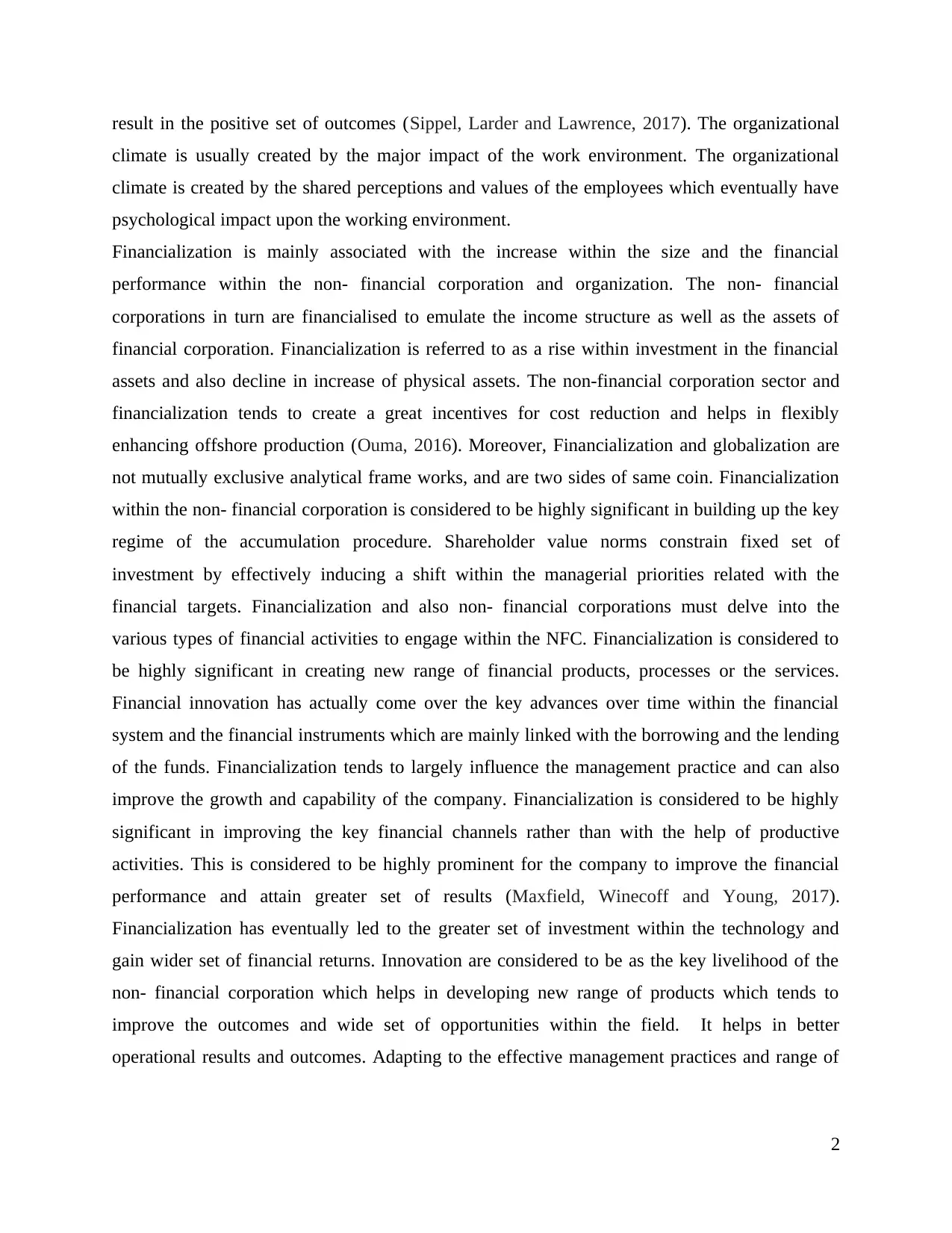
result in the positive set of outcomes (Sippel, Larder and Lawrence, 2017). The organizational
climate is usually created by the major impact of the work environment. The organizational
climate is created by the shared perceptions and values of the employees which eventually have
psychological impact upon the working environment.
Financialization is mainly associated with the increase within the size and the financial
performance within the non- financial corporation and organization. The non- financial
corporations in turn are financialised to emulate the income structure as well as the assets of
financial corporation. Financialization is referred to as a rise within investment in the financial
assets and also decline in increase of physical assets. The non-financial corporation sector and
financialization tends to create a great incentives for cost reduction and helps in flexibly
enhancing offshore production (Ouma, 2016). Moreover, Financialization and globalization are
not mutually exclusive analytical frame works, and are two sides of same coin. Financialization
within the non- financial corporation is considered to be highly significant in building up the key
regime of the accumulation procedure. Shareholder value norms constrain fixed set of
investment by effectively inducing a shift within the managerial priorities related with the
financial targets. Financialization and also non- financial corporations must delve into the
various types of financial activities to engage within the NFC. Financialization is considered to
be highly significant in creating new range of financial products, processes or the services.
Financial innovation has actually come over the key advances over time within the financial
system and the financial instruments which are mainly linked with the borrowing and the lending
of the funds. Financialization tends to largely influence the management practice and can also
improve the growth and capability of the company. Financialization is considered to be highly
significant in improving the key financial channels rather than with the help of productive
activities. This is considered to be highly prominent for the company to improve the financial
performance and attain greater set of results (Maxfield, Winecoff and Young, 2017).
Financialization has eventually led to the greater set of investment within the technology and
gain wider set of financial returns. Innovation are considered to be as the key livelihood of the
non- financial corporation which helps in developing new range of products which tends to
improve the outcomes and wide set of opportunities within the field. It helps in better
operational results and outcomes. Adapting to the effective management practices and range of
2
climate is usually created by the major impact of the work environment. The organizational
climate is created by the shared perceptions and values of the employees which eventually have
psychological impact upon the working environment.
Financialization is mainly associated with the increase within the size and the financial
performance within the non- financial corporation and organization. The non- financial
corporations in turn are financialised to emulate the income structure as well as the assets of
financial corporation. Financialization is referred to as a rise within investment in the financial
assets and also decline in increase of physical assets. The non-financial corporation sector and
financialization tends to create a great incentives for cost reduction and helps in flexibly
enhancing offshore production (Ouma, 2016). Moreover, Financialization and globalization are
not mutually exclusive analytical frame works, and are two sides of same coin. Financialization
within the non- financial corporation is considered to be highly significant in building up the key
regime of the accumulation procedure. Shareholder value norms constrain fixed set of
investment by effectively inducing a shift within the managerial priorities related with the
financial targets. Financialization and also non- financial corporations must delve into the
various types of financial activities to engage within the NFC. Financialization is considered to
be highly significant in creating new range of financial products, processes or the services.
Financial innovation has actually come over the key advances over time within the financial
system and the financial instruments which are mainly linked with the borrowing and the lending
of the funds. Financialization tends to largely influence the management practice and can also
improve the growth and capability of the company. Financialization is considered to be highly
significant in improving the key financial channels rather than with the help of productive
activities. This is considered to be highly prominent for the company to improve the financial
performance and attain greater set of results (Maxfield, Winecoff and Young, 2017).
Financialization has eventually led to the greater set of investment within the technology and
gain wider set of financial returns. Innovation are considered to be as the key livelihood of the
non- financial corporation which helps in developing new range of products which tends to
improve the outcomes and wide set of opportunities within the field. It helps in better
operational results and outcomes. Adapting to the effective management practices and range of
2
Paraphrase This Document
Need a fresh take? Get an instant paraphrase of this document with our AI Paraphraser
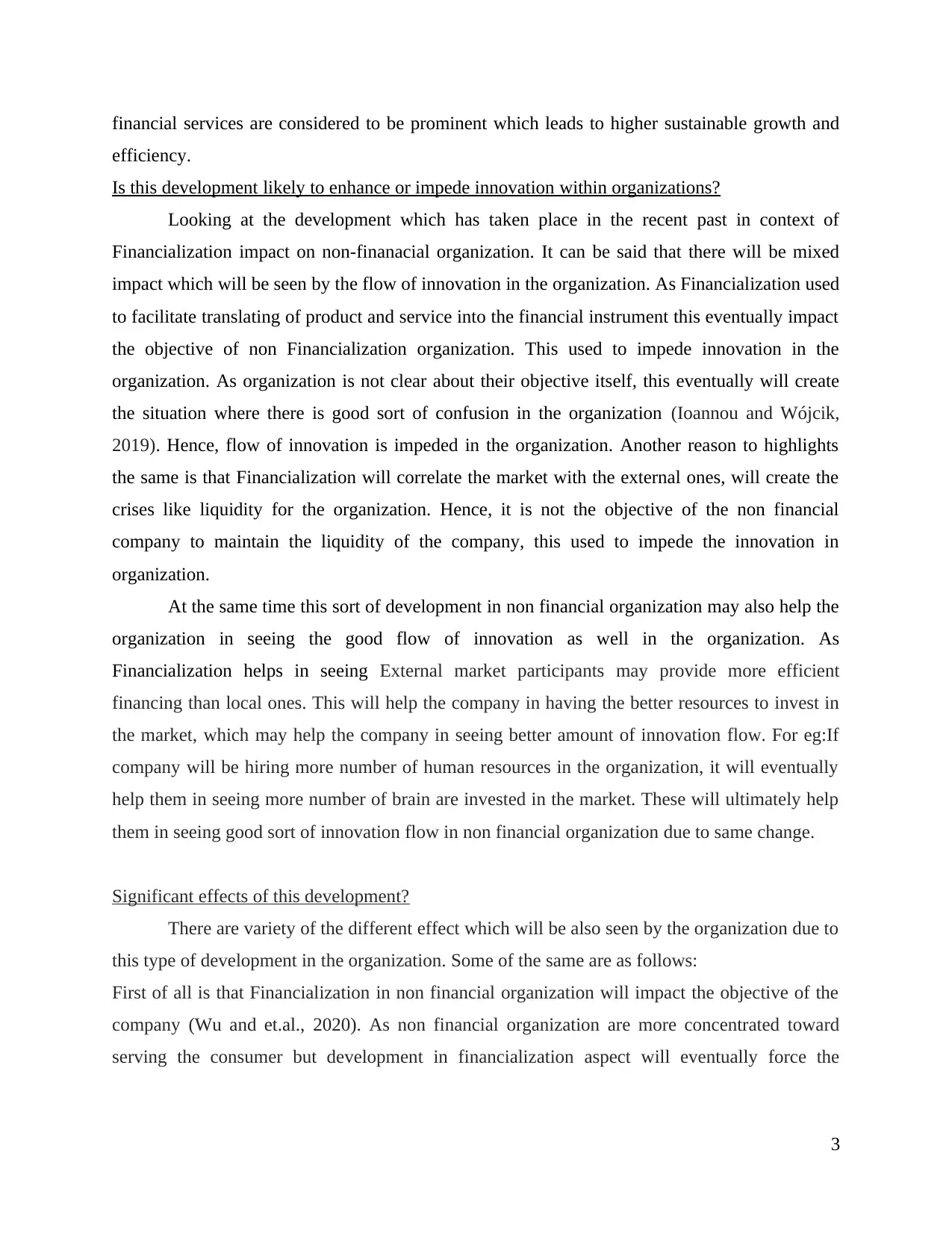
financial services are considered to be prominent which leads to higher sustainable growth and
efficiency.
Is this development likely to enhance or impede innovation within organizations?
Looking at the development which has taken place in the recent past in context of
Financialization impact on non-finanacial organization. It can be said that there will be mixed
impact which will be seen by the flow of innovation in the organization. As Financialization used
to facilitate translating of product and service into the financial instrument this eventually impact
the objective of non Financialization organization. This used to impede innovation in the
organization. As organization is not clear about their objective itself, this eventually will create
the situation where there is good sort of confusion in the organization (Ioannou and Wójcik,
2019). Hence, flow of innovation is impeded in the organization. Another reason to highlights
the same is that Financialization will correlate the market with the external ones, will create the
crises like liquidity for the organization. Hence, it is not the objective of the non financial
company to maintain the liquidity of the company, this used to impede the innovation in
organization.
At the same time this sort of development in non financial organization may also help the
organization in seeing the good flow of innovation as well in the organization. As
Financialization helps in seeing External market participants may provide more efficient
financing than local ones. This will help the company in having the better resources to invest in
the market, which may help the company in seeing better amount of innovation flow. For eg:If
company will be hiring more number of human resources in the organization, it will eventually
help them in seeing more number of brain are invested in the market. These will ultimately help
them in seeing good sort of innovation flow in non financial organization due to same change.
Significant effects of this development?
There are variety of the different effect which will be also seen by the organization due to
this type of development in the organization. Some of the same are as follows:
First of all is that Financialization in non financial organization will impact the objective of the
company (Wu and et.al., 2020). As non financial organization are more concentrated toward
serving the consumer but development in financialization aspect will eventually force the
3
efficiency.
Is this development likely to enhance or impede innovation within organizations?
Looking at the development which has taken place in the recent past in context of
Financialization impact on non-finanacial organization. It can be said that there will be mixed
impact which will be seen by the flow of innovation in the organization. As Financialization used
to facilitate translating of product and service into the financial instrument this eventually impact
the objective of non Financialization organization. This used to impede innovation in the
organization. As organization is not clear about their objective itself, this eventually will create
the situation where there is good sort of confusion in the organization (Ioannou and Wójcik,
2019). Hence, flow of innovation is impeded in the organization. Another reason to highlights
the same is that Financialization will correlate the market with the external ones, will create the
crises like liquidity for the organization. Hence, it is not the objective of the non financial
company to maintain the liquidity of the company, this used to impede the innovation in
organization.
At the same time this sort of development in non financial organization may also help the
organization in seeing the good flow of innovation as well in the organization. As
Financialization helps in seeing External market participants may provide more efficient
financing than local ones. This will help the company in having the better resources to invest in
the market, which may help the company in seeing better amount of innovation flow. For eg:If
company will be hiring more number of human resources in the organization, it will eventually
help them in seeing more number of brain are invested in the market. These will ultimately help
them in seeing good sort of innovation flow in non financial organization due to same change.
Significant effects of this development?
There are variety of the different effect which will be also seen by the organization due to
this type of development in the organization. Some of the same are as follows:
First of all is that Financialization in non financial organization will impact the objective of the
company (Wu and et.al., 2020). As non financial organization are more concentrated toward
serving the consumer but development in financialization aspect will eventually force the
3
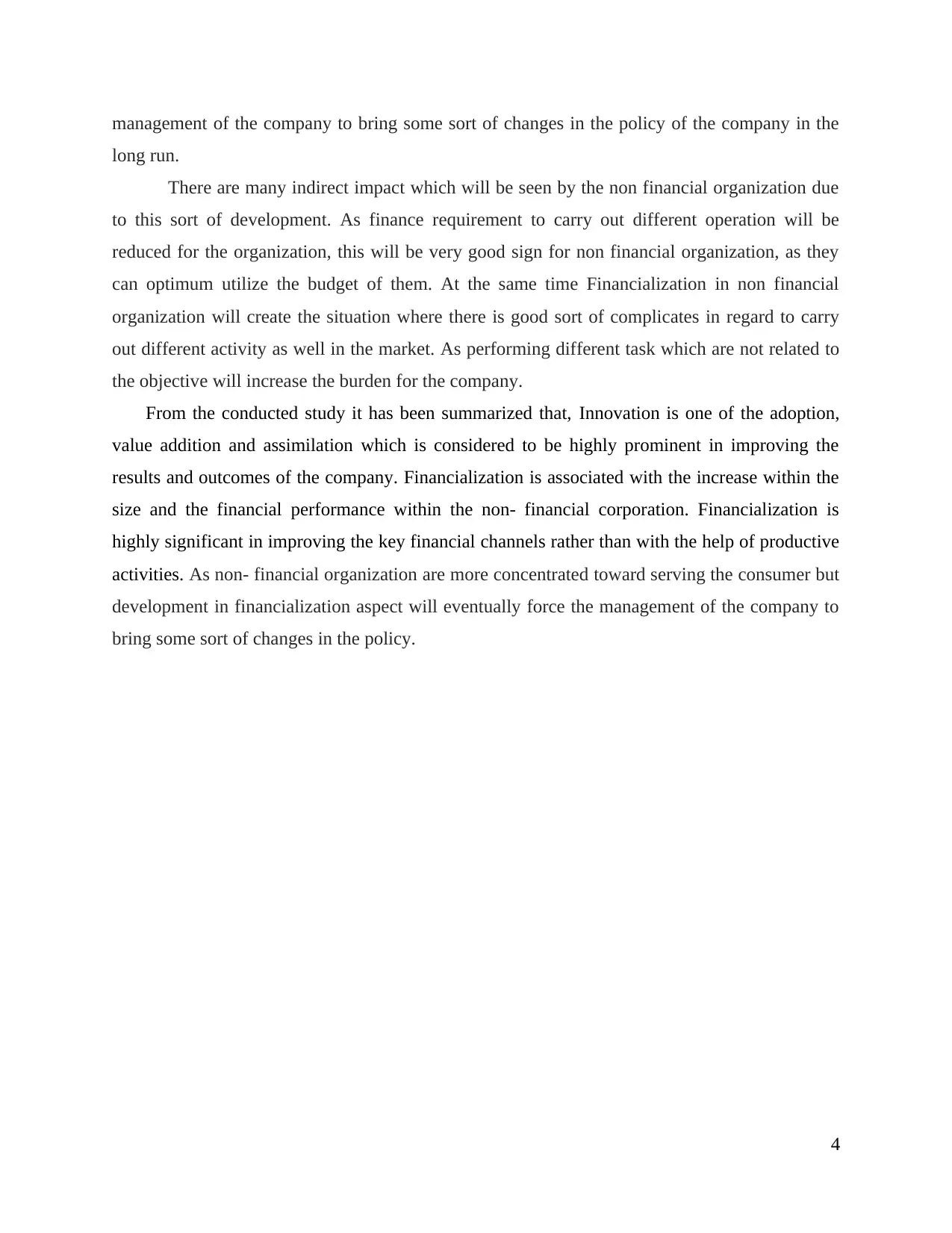
management of the company to bring some sort of changes in the policy of the company in the
long run.
There are many indirect impact which will be seen by the non financial organization due
to this sort of development. As finance requirement to carry out different operation will be
reduced for the organization, this will be very good sign for non financial organization, as they
can optimum utilize the budget of them. At the same time Financialization in non financial
organization will create the situation where there is good sort of complicates in regard to carry
out different activity as well in the market. As performing different task which are not related to
the objective will increase the burden for the company.
From the conducted study it has been summarized that, Innovation is one of the adoption,
value addition and assimilation which is considered to be highly prominent in improving the
results and outcomes of the company. Financialization is associated with the increase within the
size and the financial performance within the non- financial corporation. Financialization is
highly significant in improving the key financial channels rather than with the help of productive
activities. As non- financial organization are more concentrated toward serving the consumer but
development in financialization aspect will eventually force the management of the company to
bring some sort of changes in the policy.
4
long run.
There are many indirect impact which will be seen by the non financial organization due
to this sort of development. As finance requirement to carry out different operation will be
reduced for the organization, this will be very good sign for non financial organization, as they
can optimum utilize the budget of them. At the same time Financialization in non financial
organization will create the situation where there is good sort of complicates in regard to carry
out different activity as well in the market. As performing different task which are not related to
the objective will increase the burden for the company.
From the conducted study it has been summarized that, Innovation is one of the adoption,
value addition and assimilation which is considered to be highly prominent in improving the
results and outcomes of the company. Financialization is associated with the increase within the
size and the financial performance within the non- financial corporation. Financialization is
highly significant in improving the key financial channels rather than with the help of productive
activities. As non- financial organization are more concentrated toward serving the consumer but
development in financialization aspect will eventually force the management of the company to
bring some sort of changes in the policy.
4
⊘ This is a preview!⊘
Do you want full access?
Subscribe today to unlock all pages.

Trusted by 1+ million students worldwide
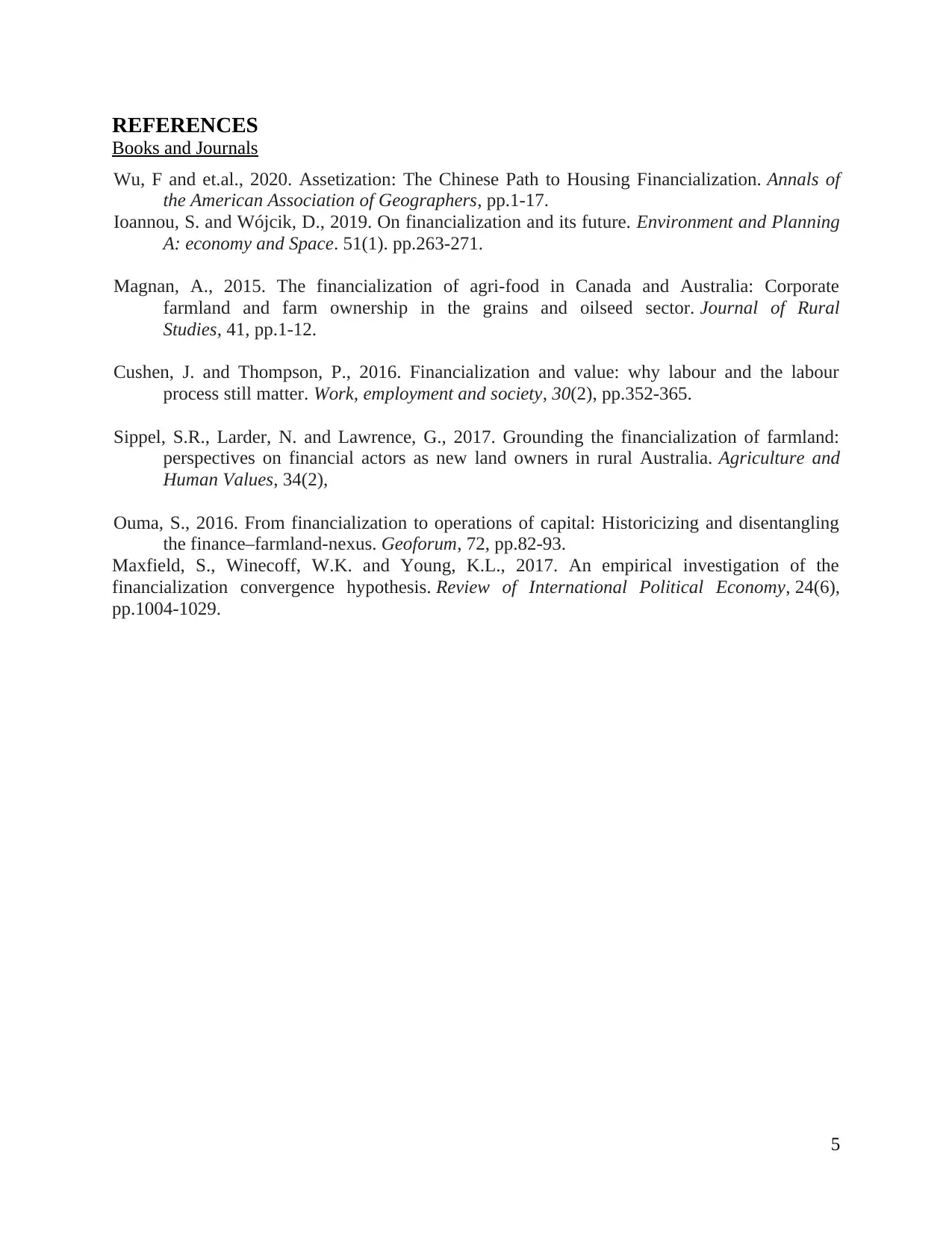
REFERENCES
Books and Journals
Wu, F and et.al., 2020. Assetization: The Chinese Path to Housing Financialization. Annals of
the American Association of Geographers, pp.1-17.
Ioannou, S. and Wójcik, D., 2019. On financialization and its future. Environment and Planning
A: economy and Space. 51(1). pp.263-271.
Magnan, A., 2015. The financialization of agri-food in Canada and Australia: Corporate
farmland and farm ownership in the grains and oilseed sector. Journal of Rural
Studies, 41, pp.1-12.
Cushen, J. and Thompson, P., 2016. Financialization and value: why labour and the labour
process still matter. Work, employment and society, 30(2), pp.352-365.
Sippel, S.R., Larder, N. and Lawrence, G., 2017. Grounding the financialization of farmland:
perspectives on financial actors as new land owners in rural Australia. Agriculture and
Human Values, 34(2),
Ouma, S., 2016. From financialization to operations of capital: Historicizing and disentangling
the finance–farmland-nexus. Geoforum, 72, pp.82-93.
Maxfield, S., Winecoff, W.K. and Young, K.L., 2017. An empirical investigation of the
financialization convergence hypothesis. Review of International Political Economy, 24(6),
pp.1004-1029.
5
Books and Journals
Wu, F and et.al., 2020. Assetization: The Chinese Path to Housing Financialization. Annals of
the American Association of Geographers, pp.1-17.
Ioannou, S. and Wójcik, D., 2019. On financialization and its future. Environment and Planning
A: economy and Space. 51(1). pp.263-271.
Magnan, A., 2015. The financialization of agri-food in Canada and Australia: Corporate
farmland and farm ownership in the grains and oilseed sector. Journal of Rural
Studies, 41, pp.1-12.
Cushen, J. and Thompson, P., 2016. Financialization and value: why labour and the labour
process still matter. Work, employment and society, 30(2), pp.352-365.
Sippel, S.R., Larder, N. and Lawrence, G., 2017. Grounding the financialization of farmland:
perspectives on financial actors as new land owners in rural Australia. Agriculture and
Human Values, 34(2),
Ouma, S., 2016. From financialization to operations of capital: Historicizing and disentangling
the finance–farmland-nexus. Geoforum, 72, pp.82-93.
Maxfield, S., Winecoff, W.K. and Young, K.L., 2017. An empirical investigation of the
financialization convergence hypothesis. Review of International Political Economy, 24(6),
pp.1004-1029.
5
1 out of 7
Related Documents
Your All-in-One AI-Powered Toolkit for Academic Success.
+13062052269
info@desklib.com
Available 24*7 on WhatsApp / Email
![[object Object]](/_next/static/media/star-bottom.7253800d.svg)
Unlock your academic potential
Copyright © 2020–2025 A2Z Services. All Rights Reserved. Developed and managed by ZUCOL.





